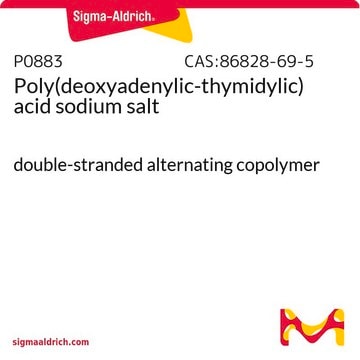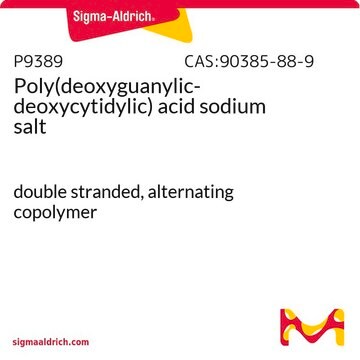P1038
Poly(cytidylic-inosinic) acid potassium salt
random copolymer
Synonyme(s) :
Poly (C,I)
Se connecterpour consulter vos tarifs contractuels et ceux de votre entreprise/organisme
About This Item
Produits recommandés
Application
Poly(cytidylic-inosinic) acid potassium salt has been used:
- in pretreatment to understand Con A-induced hepatitis in mice
- in RNA extraction from hemolymph plasma for qPCR detection assay
- to induce inflammatory changes in liver
- as a component of minimal essential medium for the stimulation of rainbow trout gonad line RTG-2 cells
Actions biochimiques/physiologiques
Poly(cytidylic-inosinic) Poly(C,I) is a random copolymer of inosine and cytidine bases which may be useful for comparative physicochemical analysis versus other random copolymers such as Poly(C,A), Poly(C,U) and Poly(C,G).
Poly(cytidylic-inosinic) acid, poly I:C mimics viral RNA to induce immune response. Administration of poly I:C promotes cytotoxic functionality of natural killer cells and macrophages. However, poly I:C may trigger generation of anti-mitochondrial antibodies (AMAs) and contribute to the pathogenesis of primary biliary cirrhosis (PBC). Poly I:C may play a hepatoprotective role in Con A-induced T cell-dependent liver injury.
Autres remarques
Random copolymer
Code de la classe de stockage
11 - Combustible Solids
Classe de danger pour l'eau (WGK)
WGK 3
Point d'éclair (°F)
Not applicable
Point d'éclair (°C)
Not applicable
Équipement de protection individuelle
Eyeshields, Gloves, type N95 (US)
Certificats d'analyse (COA)
Recherchez un Certificats d'analyse (COA) en saisissant le numéro de lot du produit. Les numéros de lot figurent sur l'étiquette du produit après les mots "Lot" ou "Batch".
Déjà en possession de ce produit ?
Retrouvez la documentation relative aux produits que vous avez récemment achetés dans la Bibliothèque de documents.
Les clients ont également consulté
Persistence of double-stranded RNA in insect hemolymph as a potential determiner of RNA interference success: evidence from Manduca sexta and Blattella germanica
Garbutt JS, et al.
Journal of Insect Physiology, 59(2), 171-178 (2013)
G F Joyce et al.
Journal of molecular biology, 188(3), 433-441 (1986-04-05)
Poly(C, G) random copolymer templates direct the oligomerization of 2-Me-ImpG and 2-MeImpC, resulting in the production of a variety of oligo(G, C)s. The efficiency of monomer incorporation into newly synthesized oligomers is greater for 2-MeImpG than for 2-MeImpC, and decreases
G F Joyce et al.
Journal of molecular biology, 176(2), 279-306 (1984-06-25)
Poly(C, U) random copolymer templates direct the oligomerization of 2-MeImpG and 2-MeImpA, resulting in the production of a variety of oligo/(G,A)s. The efficiency of monomer incorporation into newly synthesized oligomers is greater for 2-MeImpG than for 2-MeImpA, and decreases for
G F Joyce et al.
Journal of molecular biology, 202(3), 677-681 (1988-08-05)
Poly(C,A) random copolymer templates direct the oligomerization of 2-MeImpG (2-MeImpX is the 5'-phospho-2-methylimidazolide of the nucleoside X) and 2-MeImpU, resulting in the production of a variety of oligo (G,U)s. This reaction is less efficient than comparable reactions involving poly(C,U) or
The multi-hit hypothesis of primary biliary cirrhosis: polyinosinic-polycytidylic acid (poly I: C) and murine autoimmune cholangitis
Wang J, et al.
Journal of Hepatology, 44(3), 446-454 (2006)
Notre équipe de scientifiques dispose d'une expérience dans tous les secteurs de la recherche, notamment en sciences de la vie, science des matériaux, synthèse chimique, chromatographie, analyse et dans de nombreux autres domaines..
Contacter notre Service technique












